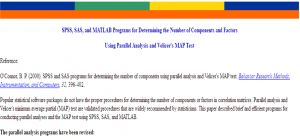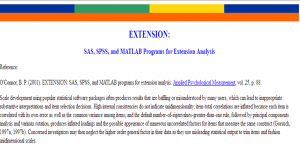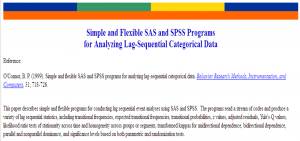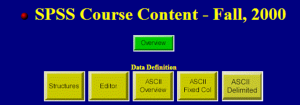Intermediate Statistics
Posted by Armando Brito Mendes | Filed under estatística, materiais ensino, software, videos
Welcome to the wood of suicides (is anyone getting all these Dante references or am I just wasting my time here?), where self flagellation is the name of the game. You will experience the bowel-evacuating effect of multiple regression, the bone-splintering power of ANOVA and the nose-hair pulling torment of factor analysis. Can you cope: I think not, mortal filth. Be warned, your brain will be placed in a jar of cerebral fluid and I will toy with it at my leisure.
Tags: decisão médica, IBM SPSS Statistics, inferência, software estatístico
PANDA – Practical Analysis of Nutritional Data
Posted by Armando Brito Mendes | Filed under estatística, materiais ensino, software, visualização
Chapter 1 – USING NUTRITIONAL DATA
Chapter 2 – DATA CLEANING
Chapter 3 – ONE-WAY ANALYSIS
Chapter 4 – TWO-WAY ANALYSIS
Chapter 5 – MULTI-WAY ANALYSIS
Chapter 6 – SUBMODULES
Chapter 7 – ASSESS YOUR UNDERSTANDING
Chapter 8 – KENYA REAL WORLD ANALYSIS
Building and presenting a situation analysis
Child Feeding Practices
Tags: análise de dados, decisão médica, Estat Descritiva, IBM SPSS Statistics, inferência, software estatístico
Determining the Number of Components and Factors Using Parallel Analysis and Velicer’s MAP Test
Posted by Armando Brito Mendes | Filed under estatística, software, visualização
Popular statistical software packages do not have the proper procedures for determining the number of components or factors in correlation matrices. Parallel analysis and Velicer’s minimum average partial (MAP) test are validated procedures that are widely recommended by statisticians. This paper described brief and efficient programs for conducting parallel analyses and the MAP test using SPSS, SAS, and MATLAB.
Scale development using popular statistical software packages often produces results that are baffling or misunderstood by many users, which can lead to inappropriate substantive interpretations and item selection decisions. High internal consistencies do not indicate unidimensionality; item-total correlations are inflated because each item is correlated with its own error as well as the common variance among items; and the default number-of-eigenvalues-greater-than-one rule, followed by principal components analysis and varimax rotation, produces inflated loadings and the possible appearance of numerous uncorrelated factors for items that measure the same construct (Gorsuch, 1997a, 1997b). Concerned investigators may then neglect the higher order general factor in their data as they use misleading statistical output to trim items and fashion unidimensional scales.
These problems can be circumvented in exploratory factor analysis by using more appropriate factor analytic procedures and by using extension analysis as the basis for adding items to scales. Extension analysis provides correlations between nonfactored items and the factors that exist in a set of core items. The extension item correlations are then used to decide which factor, if any, a prospective item belongs to. The decisions are unbiased because factors are defined without being influenced by the extension items. One can also examine correlations between extension items and any higher order factor(s) in the core items. The end result is a comprehensive, undisturbed, and informative picture of the correlational structure that exists in a set of core items and of the potential contribution and location of additional items to the structure.
Tags: análise de dados, captura de conhecimento, decisão médica, desnvolvimento de software, IBM SPSS Statistics, software estatístico
SPSS Programs for Analyzing Lag-Sequential Categorical Data
Posted by Armando Brito Mendes | Filed under estatística, materiais ensino, software
This paper describes simple and flexible programs for conducting lag sequential event analyses using SAS and SPSS. The programs read a stream of codes and produce a variety of lag sequential statistics, including transitional frequencies, expected transitional frequencies, transitional probabilities, z values, adjusted residuals, Yule’s Q values, likelihood ratio tests of stationarity across time and homogeneity across groups or segments, transformed kappas for unidirectional dependence, bidirectional dependence, parallel and nonparallel dominance, and significance levels based on both parametric and randomization tests.
Tags: captura de conhecimento, data mining, desnvolvimento de software, IBM SPSS Statistics, previsão, qualidade, software estatístico
Logistic regression and discriminant analysis
Posted by Armando Brito Mendes | Filed under estatística, materiais ensino, software
Contents of this handout: The problem of dichotomous dependent variables; Discriminant analysis; Logistic regression – theory; Logistic regression (and discriminant analysis) in practice; Interpreting and reporting logistic regression results; References and further reading; Examples.
Tags: IBM SPSS Statistics, inferência, software estatístico
Analysis Of Categorical Dependent Variables
Posted by Armando Brito Mendes | Filed under estatística, materiais ensino, software
- Models for Binary Outcomes
- Models for Multiple Outcomes
Tags: IBM SPSS Statistics, inferência
Statistics on Likert Scale Surveys
Posted by Armando Brito Mendes | Filed under estatística, materiais para profissionais, software
Reading in the survey from optical mark scanning sheet data
Producing a Table of the frequency results
Producing Means and Standard Deviations
Using T-Tests to compare groups
About the assumptions of the T-Test
An Alternative to T-Tests: the Chi Square Statistic
Computing Subscales and what to do about reverse wording
Tags: análise de dados, IBM SPSS Statistics, inferência, inquéritos, software estatístico
SPSS Course Content
Posted by Armando Brito Mendes | Filed under estatística, materiais ensino, software
Data Transformations
File Transformations
Crosstabulation and Measures of Association
Differences Between Two Groups
ANOVA: Between Subjects
—————————–General Linear Model (GLM)—————————
ANOVA: Repeated Measures
———General Linear Model (GLM)———
Tags: análise de dados, IBM SPSS Statistics, inferência, inquéritos, software estatístico
SPSS Topics Multilevel Modeling
Posted by Armando Brito Mendes | Filed under estatística, materiais ensino, software
SPSS Topics
Multilevel Modeling
These pages contain links from all parts of our web site and others web sites on multilevel modeling. The topics will vary from introductory to advanced.
SPSS Frequently Asked Questions
SPSS Textbook Examples
SPSS Paper Examples
SPSS Library
Code Fragments
Tags: análise de dados, IBM SPSS Statistics, inferência, software estatístico
SPSS Topics Logistic Regression
Posted by Armando Brito Mendes | Filed under estatística, materiais ensino, software
SPSS Topics
Logistic Regression
These pages contain links from all parts of our web site and others web sites on logistic and related types of regression. The topics will vary from introductory to advanced.
Data Analysis Examples
Annotated Output
SPSS Frequently Asked Questions
Textbook Examples
SPSS Library
SPSS Code Fragments
Tags: análise de dados, captura de conhecimento, data mining, IBM SPSS Statistics, inferência, inquéritos, software estatístico







